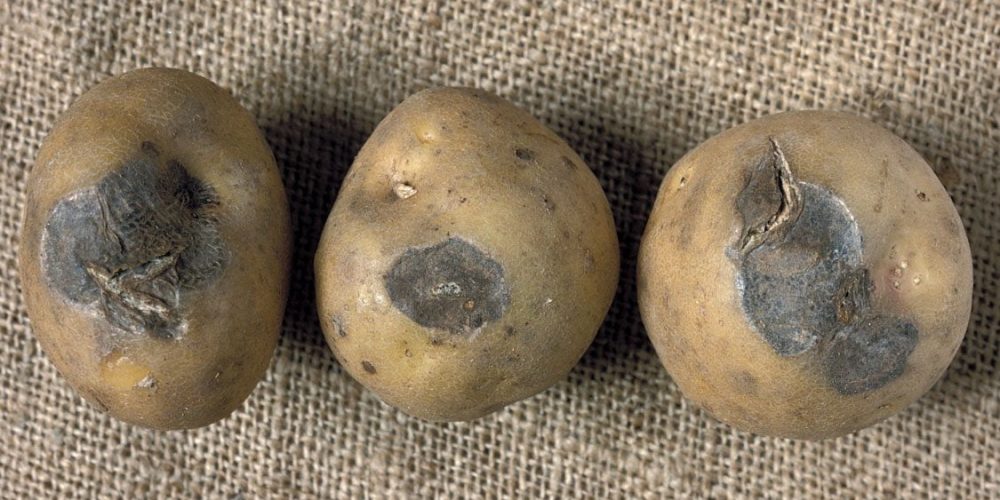Table of contents of the article
Toggle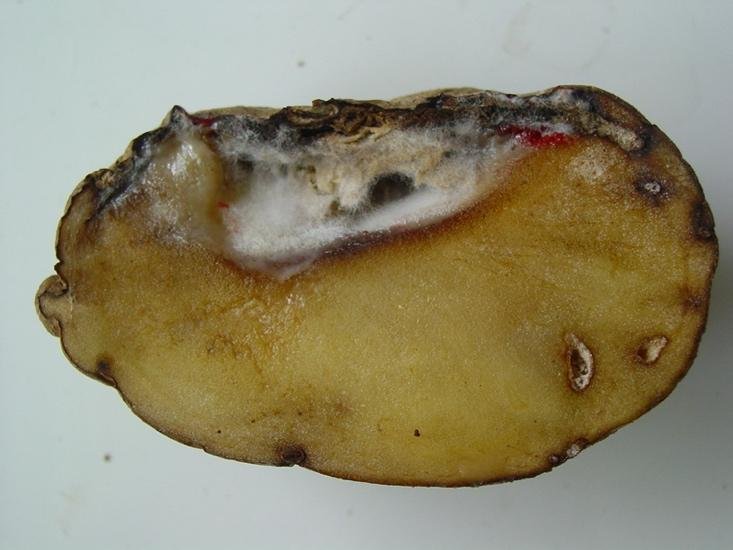
Dry rot is a fungal disease that affects potato tubers, causing dryness and cracks that affect the quality of the crop. This article from the “WORLD OF PLANTS” website discusses how to prevent and effectively control dry rot disease in potato tubers.
Identification of dry rot in potato tubers
Name of the disease: Dry rot in potatoes
Scientific name: Fusarium spp.
Type of disease: Fungal disease
Fungal family: Nectriaceae
Potatoes, as a global staple food, face diverse disease threats that can significantly impact the production and quality of the crop. One of these powerful diseases is Fusarium dry rot, a fungal disease caused by the Fusarium genus. In this article, we will go into detail about Fusarium rot of potatoes, exploring its life cycle, symptoms, favorable conditions, causes of disease development, infection losses, and effective control and prevention measures.
Life cycle of dry rot in potato tubers
The life cycle of Fusarium rot on potatoes is inherited through a complex interaction involving the Fusarium pathogen. The cycle begins with the presence of Fusarium-infected potato seeds or Fusarium-contaminated soil. Once inside, the fungus colonizes the tubers and, under appropriate conditions, the fungus produces spores. These spores can survive for long periods in the soil or on crop residue, facilitating recurrence of infection in subsequent cropping seasons.
Symptoms of dry rot in potato tubers
1. Early symptoms
The signs of Fusarium dry rot in its early stages are often subtle, making early detection difficult. Initial symptoms can include wilting, yellowing, and stunted growth of plants. In addition, infected potatoes may generally develop small, round ulcers on their surface.
2. Advanced symptoms
As the disease progresses, more obvious symptoms appear. Affected potatoes develop dry, brown, necrotic areas, often accompanied by a powdery texture. The potato's inner texture becomes dry and leathery, making the potato unfit for consumption.
3. Characteristic symptoms
One of the characteristic symptoms of Fusarium dry rot is the presence of pink or red discoloration in the vascular tissue of infected potatoes. This coloration is a key diagnostic feature, helping to differentiate Fusarium-infected potato seeds from other potato diseases.
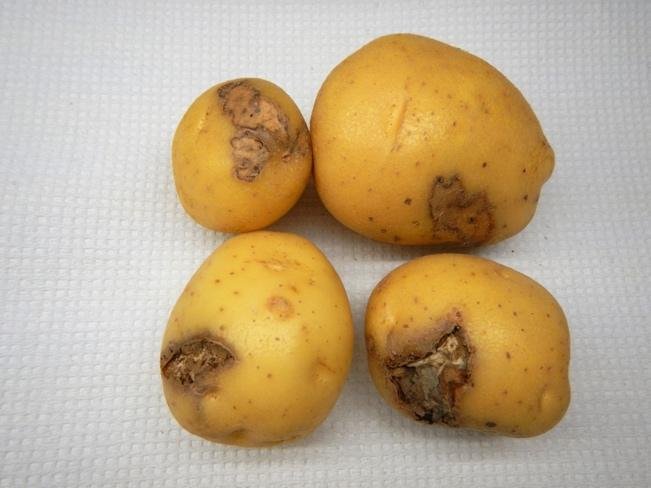
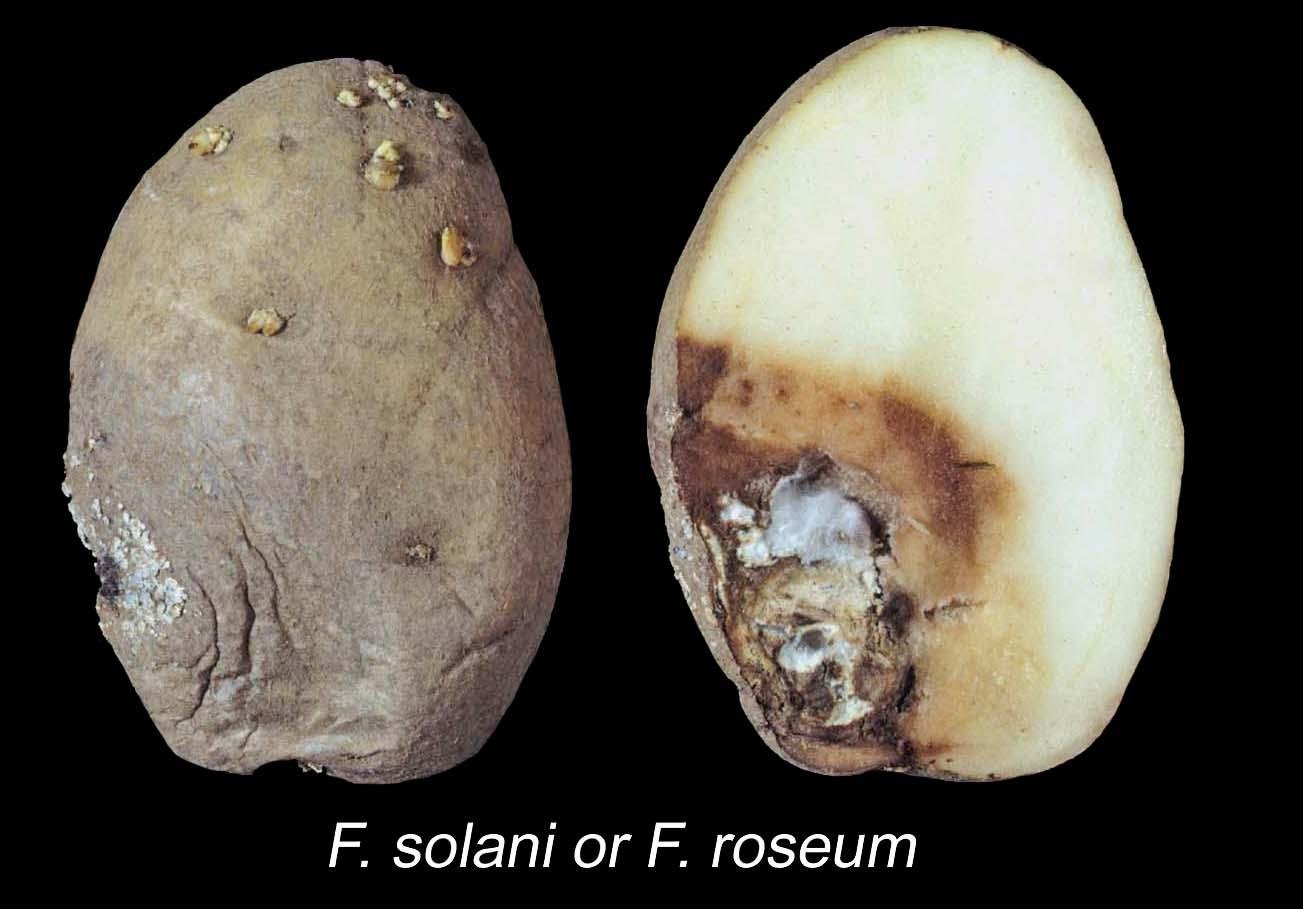
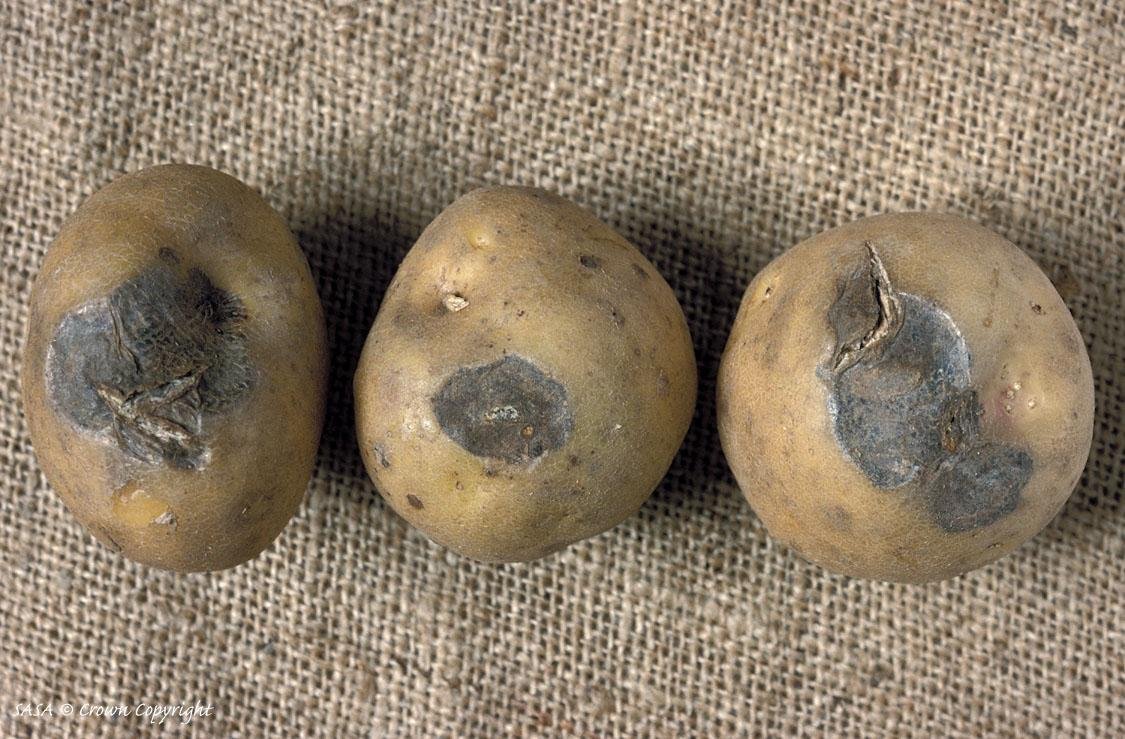
Favorite conditions for dry rot in potato tubers
1. Seasonal conditions
Fusarium dry rot prefers nice, moist conditions, usually during the spring and fall. The optimum temperature is in the range of 15-25 degrees Celsius. While Fusarium can survive in storage under cool, dry conditions, it also thrives when combined with moisture.
2. Soil conditions
Fusarium species generally prefer soil with good drainage and a slightly acidic to alkaline PH (6.5-7.5). While poor drainage and water accumulation can create an environment conducive to disease development, some species can tolerate moderately heavy soil as long as adequate aeration is present.
3. Environmental conditions
While Fusarium dry rot is most associated with open-field crop cultivation, it may also appear in protected growing environments. Greenhouses with high levels of humidity and lack of ventilation can provide an ideal environment for mushrooms to thrive.
Causes of dry rot in potato tubers
Several factors contribute to the development of Fusarium dry rot on potatoes:
- Infected tubers: Planting potatoes that are already infected with Fusarium greatly increases the risk of developing the disease.
- Suitable environmental conditions: Nice and humid weather creates an optimal environment for Fusarium growth and spore production.
- Poor soil drainage: Lack of soil drainage increases the likelihood of waterlogged conditions, creating an environment that facilitates Fusarium development.
- Contaminated tools: Using contaminated tools while planting or harvesting potatoes can introduce the Fusarium pathogen into healthy potato crops.
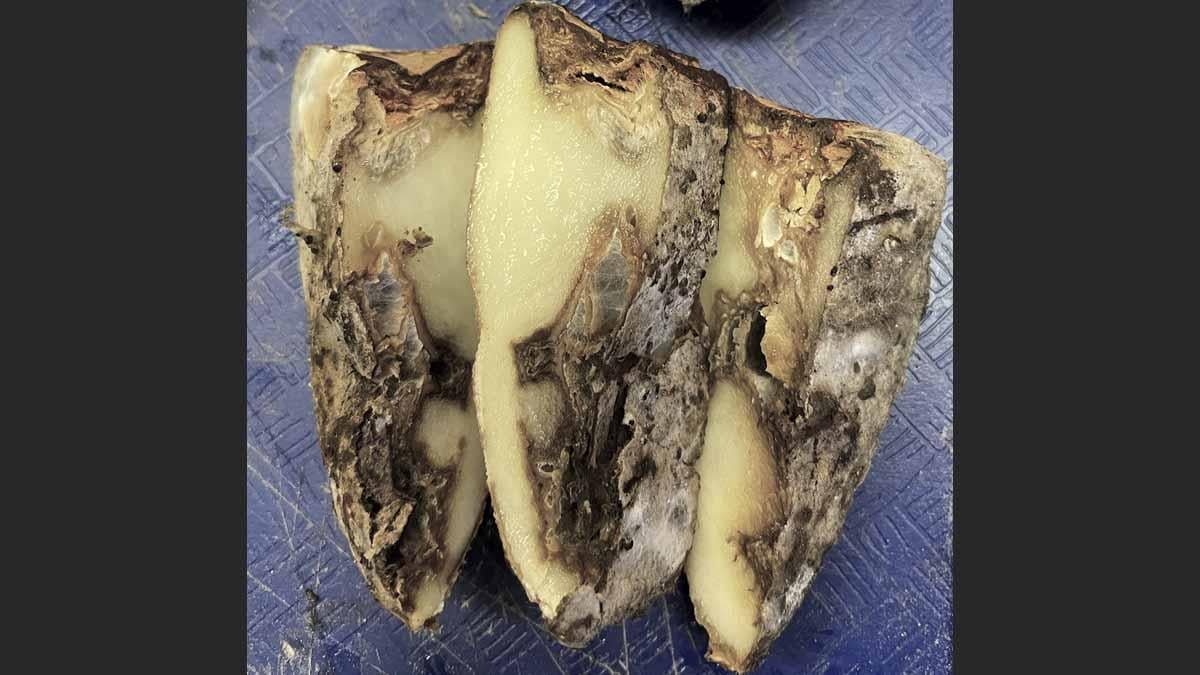
Dry rot losses in potato tubers
Fusarium dry rot can lead to huge economic losses for potato growers. Infected seeds are not only unsuitable for consumption but also detrimental to the quality of processed potato products. In addition, post-harvest losses can occur during storage, further affecting overall production.
Control strategy for dry rot in potato tubers
A. Agricultural practices
- Agricultural rotation: Rotating crops to break the disease cycle and reduce the accumulation of the pathogen in the soil.
- Proper irrigation: Ensure regulated irrigation practices to prevent water accumulation and excess moisture in the soil.
B. Chemical methods
- Phosphorous fungicides: Fungicides containing phosphorous acid, such as aluminum fusetyl, have shown effectiveness in controlling Fusarium dry rot on potatoes.
- Copper fungicides: Copper compounds, such as copper hydroxide or copper sulphate, are used as preventatives against Fusarium dry rot, providing a chemical barrier to the pathogen.
- Benzimidazole-based fungicides: The use of benzimidazole-based fungicides in disease management practices can be effective in inhibiting the development of Fusarium dry rot.
- Dicarboximide-based fungicides: Dicarboximide-based fungicides, such as iprodione, are another chemical option for controlling Fusarium and mitigating the spread of the disease.
In addition to the fungicides mentioned, there are several other options that provide effective control against Fusarium dry rot. The strobilurin fungicides, such as azoxystrobin and fluazinam, provide additional tools for disease control. Choosing the appropriate fungicide depends on factors such as the specific Fusarium strain, disease severity, and environmental conditions. A consultation with a qualified agricultural specialist can help you choose the best fungicide for your situation.
C. Organic methods
- Garlic Extracts: Organic substances extracted from garlic, known for their antifungal properties, can be applied to control Fusarium dry rot, offering a natural and environmentally friendly approach.
- Neem Oil: Neem oil, extracted from the neem tree, has been recognized for its fungicidal properties and can be used as an organic solution for managing Fusarium dry rot on potato crops.
- Essential Oils: Using essential oils, such as tea tree oil or cinnamon oil, as organic fungicides offers an environmentally friendly approach to controlling Fusarium dry rot.
- Chitosan-based products: Chitosan, a natural polysaccharide derived from the peel of crustaceans, has demonstrated antifungal properties and can be applied as an organic management of the disease.
D. Biological methods
- Beneficial microorganisms: Introducing beneficial microorganisms, such as mycorrhizal fungi, to enhance plant resistance against Fusarium.
- Bacillus bacteria: Beneficial bacteria belonging to the genus Bacillus, such as Bacillus subtilis, can be used as a biological control agent, where Fusarium rot is suppressed by competition with the pathogen.
- Predatory nematodes: Some predatory nematode species, such as Steinernema velti, display the ability to parasitize Fusarium blooms in soil, providing a biological defense against the pathogen.
- Trichoderma fungus-based biopesticides: Exploitation of specific Trichoderma fungus strains as biopesticides enhances biological control against Fusarium dry rot.
- Plant Root Growth Promoting Bacteria (PGPR): Introduction of PGPR, such as Pseudomonas fluorescens, can stimulate plant growth and elicit systemic resistance against Fusarium dry rot.
Preventive measures dry rot in potato tubers
- Certified Tubers: Plant certified disease-free tubers to reduce the risk of introducing Fusarium to the crop.
- Monitoring and early detection: Checking the crop regularly to detect symptoms and removing infected plants quickly can prevent the spread of the disease.
- Provide adequate ventilation: Ensure good ventilation in storage facilities to reduce humidity and inhibit Fusarium growth.
- Quarantine measures: Implement quarantine measures for equipment and machinery to prevent the unintentional spread of the pathogen.
- Soil improvement: Improving soil drainage and structure through sound management practices to create an unfavorable environment for Fusarium.
Conclusion
Fusarium dry rot poses a major threat to potato crops, affecting both productivity and quality. Understanding the life cycle of the disease, its symptoms, and factors contributing to its development is essential to manage it effectively. Using a comprehensive control strategy, including physical, chemical, organic and biological methods, combined with diligent preventative measures, can help mitigate the impact of Fusarium dry rot and protect potato crops to ensure sustainable agriculture.
We would like to point out that we, on the World of Plants website, provide you with all the services you need in the world of plants. We provide all farmers and those interested in plants with three main services: -
- Artificial intelligence consulting service to help you identify diseases that affect plants and how to deal with them.
- Blog about plants, plant diseases and care of various crops ... You are currently browsing one of her articles right now.
- An application that provides agricultural consultations to clients, as well as a service for imaging diseases and knowing their treatment for free – Click to download the Android version from Google Play Store، Click to download the IOS version from the Apple App Store.




